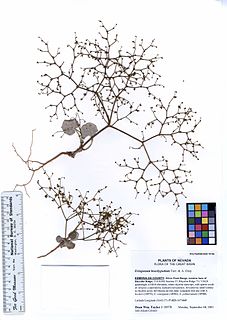
Eriogonum brachypodum is a species of wild buckwheat known by the common name Parry's buckwheat. This annual herb is native to the southwestern United States from California to Utah, especially the Mojave Desert, where it grows in sandy and gravelly substrates. It has a skeletonlike spindly stem which branches many times, reaching anywhere from 5 to 50 centimeters in height and up to a meter in width. There is an array of rounded, dark-colored leaves around the base, each a few centimeters long and fuzzy on the undersides. Most of the plant is actually the spreading inflorescence. At intervals on the otherwise naked branches hang tiny clusters of glandular flowers a few millimeters wide in involucres of bell-shaped bracts. Each flower is less than three millimeters wide.
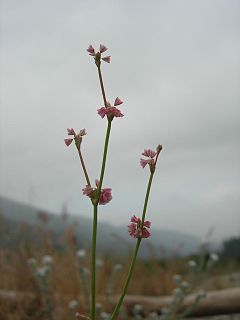
Eriogonum davidsonii is a species of wild buckwheat known by the common name Davidson's buckwheat. This plant is native to the southwestern United States and northern Baja California, where it grows in sandy or gravelly soils in a variety of habitats. It is a spindly annual herb growing up to 40 centimeters in height. The fuzzy leaves are located at the base of the plant and are one or two centimeters wide and round with wavy or wrinkly margins. It is variable in appearance, but is generally erect with thin, naked, neatly branching stems bearing clusters of tiny flowers at widely spaced nodes. Each flower is about 2 millimeters wide, bell-shaped, and usually pink.

Eriogonum deflexum is a species of wild buckwheat known by the common names flatcrown buckwheat, flat-top buckwheat, and skeletonweed. This plant is native to the southwestern United States and northwestern Mexico, where it is common and grows in a variety of habitats, especially desert scrub. It is somewhat weedy where it is most abundant. This is an annual which varies in size from small patches on the ground to tangled bushes approaching two meters in height; it may be dense or thin and spindly. This is a brown or greenish weedy-looking herb with a many-branched stem. The leaves are located at the base of the plant and are rounded and woolly and one to four centimeters long. Small clusters of flowers appear at intervals along the branches with each flower only one to three millimeters wide and white or pinkish in color.
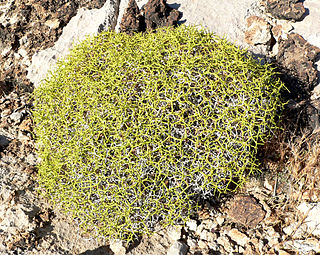
Eriogonum heermannii is a species of wild buckwheat known by the common name Heermann's buckwheat. It is native to the southwestern United States from California to Utah where it grows on rocky slopes, desert flats, and dry washes.

Eriogonum lobbii is a species of wild buckwheat known by the common name Lobb's buckwheat or prostrate buckwheat. It is native to most of the mountain ranges of northern California and their extensions into Oregon and Nevada. It is found in a number of mountain plant communities.

Eriogonum ursinum is a species of wild buckwheat known by the common names Bear Valley buckwheat and talus buckwheat. It is endemic to northern California where it is found on mountains from the northern Sierra Nevada to the southern Klamath Mountains.
Chorizanthe diffusa is a species of flowering plant in the buckwheat family known by the common name diffuse spineflower. It is endemic to California, where it grows on the coastline and mountains of the Central Coast, in sandy scrub, woodland, and forest habitat. It is erect to prostrate in form, its stem generally no longer than 15 or 20 centimeters. The leaves are up to 2 centimeters long and mainly arranged about the base of the plant. The inflorescence is a cluster of flowers, each surrounded by six hook-tipped bracts. The margins of the bracts proximal to the long hooked tip may be very thin and nearly invisible to wide and obvious, and they may be green to white to purplish. The flower itself is about 3 millimeters wide and white with a yellow throat. The tips of its tepals may be smooth or jagged or toothed.
Chorizanthe watsonii is a species of flowering plant in the buckwheat family known by the common name fivetooth spineflower. It is native to the western United States from Washington to the Mojave Desert. It grows in many types of plant communities from desert scrub to woodland and sagebrush. This small plant grows a woolly erect stem up to about 15 centimeters tall. The inflorescence is a cluster of flowers surrounded by five hairy greenish bracts tipped with hooked awns. The flower is about 2 millimeters wide and yellow in color.
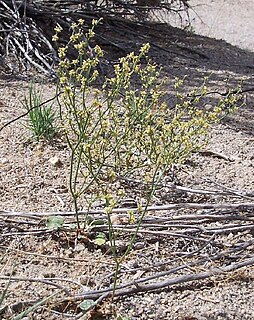
Eriogonum ampullaceum is a species of wild buckwheat known by the common name Mono buckwheat.

Eriogonum brachyanthum is a species of wild buckwheat known by the common name shortflower buckwheat. It is native to eastern California and western Nevada, particularly the Mojave Desert region, where it is common to abundant, and even sometimes weedy. It is also known from southern Oregon. The plant grows in sandy habitat, such as desert flats and sagebrush. It is an annual herb reaching 30 to 40 centimeters tall. The woolly leaves are oval or rounded and are located about the base of the stem. The top of the stem is occupied by a branching inflorescence bearing many widely spaced clusters of flowers. Each individual flower is about a millimeter wide and light yellow in color.
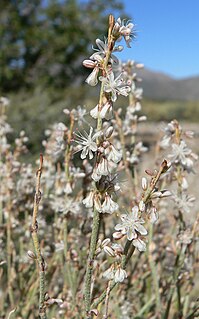
Eriogonum panamintense is a species of wild buckwheat known by the common name Panamint Mountain buckwheat. It is native to several of the desert mountain ranges of eastern California and western Nevada, including the Panamint Range. It grows in various types of mountain ridge habitat, such as sagebrush and coniferous woodland.
Eriogonum pendulum is a rare species of wild buckwheat known by the common name Waldo buckwheat. It is endemic to the Klamath Mountains of Josephine County, Oregon, and Del Norte County, California, where it is a member of the serpentine soils flora.

Eriogonum ternatum is a species of wild buckwheat known by the common name ternate buckwheat. It is native to mountain ranges of northern California and southern Oregon, where it grows in the serpentine soil of the forests. This is a perennial herb forming mats up to half a meter wide with rosetted clusters of oval to rounded woolly leaves each about a centimeter long. The inflorescence arises on a flowering stem and bears an umbel of bright yellow flowers.
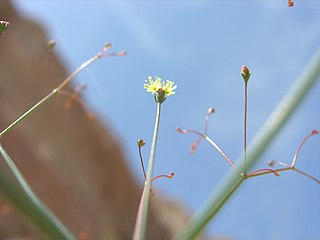
Eriogonum thomasii is a species of wild buckwheat known by the common name Thomas' buckwheat. It is native to the desert southwest of the United States and northern Mexico where it is common in many areas, sometimes becoming a weed.

Eriogonum viridescens is a species of wild buckwheat known by the common name twotooth buckwheat. It is endemic to California, where it grows in the Central Coast Ranges through the Transverse Ranges and into the Mojave Desert, as well as in the Central Valley. It grows in a variety of habitat types, generally on clay and sandy soils.

Eriogonum callistum is a rare species of wild buckwheat, known by the common name Tehachapi buckwheat.

Eriogonum spectabile is a rare species of wild buckwheat known by the common name Barron's buckwheat. It is endemic to Plumas County, California, where it is known from two occurrences in Lassen National Forest near Chester. There are approximately 250 individuals in existence. It grows in scrubby, forested mountain habitat, only on glaciated andesite substrates. This rare plant was discovered in 1997 and described to science as a new species in 2001.

Eriogonum argophyllum is a species of wild buckwheat known by the common names Sulphur Hot Springs buckwheat, Silver Lake buckwheat, and Ruby Valley buckwheat. It is endemic to Nevada in the United States, where there is only one known population.
Eriogonum diatomaceum is a species of wild buckwheat known by the common name Churchill Narrows buckwheat. It is endemic to Nevada in the United States, where it is known only from the Pine Nut Mountains in Lyon County. It is limited to the Churchill Narrows near Fort Churchill State Historic Park. This plant was discovered in 1997 and described to science in 2002.

Eriogonum thymoides is an "abundant" species of flowering plant in the buckwheat family known by the common name thymeleaf wild buckwheat, or simply thymeleaf buckwheat.
















